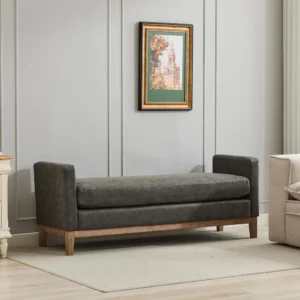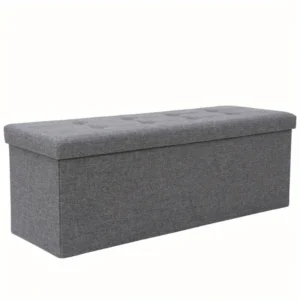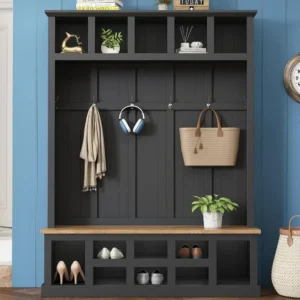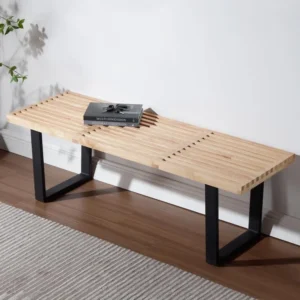The Enduring Appeal of Rustic Farmhouse Benches
There’s something deeply satisfying about a well-crafted rustic farmhouse bench that transcends passing trends. These pieces speak to our desire for authenticity in our homes—a connection to craftsmanship and natural materials that feels increasingly precious in our mass-produced world. A true rustic farmhouse bench combines several key elements: natural materials that showcase their origins, weathered finishes that tell a story, sturdy construction that promises longevity, and practical functionality that serves daily life.
What makes these pieces so special is how they blend warmth and welcome with honest utility. Unlike more formal furniture that can feel stiff or precious, farmhouse benches invite you to sit, gather, and live. Their beauty comes from their straightforward purpose and the natural character of their materials rather than elaborate ornamentation or perfect symmetry.
The versatility of farmhouse benches is perhaps their greatest strength. From entryways to dining rooms, living spaces to bedrooms, these adaptable pieces work as both functional workhorses and statement pieces that anchor a room’s design. Their straightforward lines and honest materials allow them to complement many decorating styles while adding texture and warmth.
These benches connect us to a simpler time when furniture was built to last generations and served multiple purposes in the home. Traditional farmhouses relied on benches as practical seating that could be moved where needed—from table to hearth to porch. Today, this same practical spirit makes authentic rustic farmhouse bench styles relevant in contemporary homes where functionality and character are equally valued.
The resurgence of farmhouse style in modern interior design isn’t simply nostalgia. It represents a genuine desire for homes that feel lived-in, welcoming, and authentic. Farm benches embody this ideal perfectly—they’re meant to be used daily, to weather gracefully, and to become more beautiful with age. Their imperfections tell stories and create character that mass-produced furniture simply cannot match.
The historical context of farmhouse bench usage reminds us that these pieces were born of necessity and resourcefulness. Today, they remain a worthwhile investment precisely because they combine this honest heritage with enduring functionality. A well-made rustic bench doesn’t just serve your needs today—it promises to become an heirloom piece that grows more meaningful with each passing year.
Signature Elements of Authentic Rustic Farmhouse Benches
To truly understand what makes a rustic farmhouse bench special, we need to look beyond surface-level style to the core elements that define these timeless pieces. Authentic farmhouse benches share certain characteristics that distinguish them from mass-produced imitations, creating pieces with genuine character and lasting appeal.
At the heart of every true rustic farmhouse bench is the material choice. Quality wood materials for authentic rustic benches showcase natural beauty and character that simply can’t be faked. The most common woods include:
- Pine: Affordable with prominent knots and grain patterns that create visual interest
- Oak: Exceptionally durable with distinctive grain that adds texture and dimension
- Reclaimed timber: Salvaged from old barns, factories, or homes, bringing history and unique patina
- Elm, maple, or acacia: Alternative species that each bring their own distinctive character and color variation
What makes these woods special in farmhouse pieces is how they’re handled—authentic rustic benches celebrate rather than conceal the natural character of wood. Knots, grain patterns, and even minor imperfections are highlighted as part of the design rather than hidden or removed.
Construction methods play an equally important role in defining authentic farmhouse style. Traditional joinery techniques like mortise and tenon, dovetail joints, or simple butt joints secured with visible pegs speak to craftsmanship and durability. These methods not only ensure structural integrity but also add visual interest and authenticity to the piece.
The finishes used on rustic farmhouse benches strike a delicate balance. They must protect the wood while enhancing—rather than masking—its natural beauty. Authentic farmhouse design elements typically include:
- Matte or satin finishes that feel natural to the touch
- Slightly distressed or weathered surfaces that suggest age and use
- Hand-rubbed oils or waxes that penetrate the wood rather than coating it
- Natural color variations that highlight the wood’s inherent beauty
Clean, simple lines define the silhouette of farmhouse benches. While they may incorporate subtle details like gently curved edges or tapered legs, they avoid unnecessary ornamentation or elaborate carving. This simplicity reflects the practical origins of farm furniture, where function dictated form and materials were used efficiently.
The color palette of rustic farmhouse pieces typically draws from nature—warm wood tones, creamy whites, soft grays, and muted earth tones. Even painted pieces tend toward these neutral, natural hues that complement rather than compete with the wood’s natural beauty.
What truly separates authentic rustic farmhouse benches from mass-produced versions is patina—that irreplaceable quality that comes from natural aging and honest use. While new pieces can incorporate distressing techniques to suggest age, genuine character develops over time as wood responds to its environment and human touch.
This combination of quality materials, thoughtful construction, appropriate finishing, and simple design creates pieces that feel both grounded in tradition and perfectly at home in contemporary spaces. Understanding these signature elements helps you recognize quality when shopping or planning your own farmhouse-inspired spaces.
Entryway Benches: Creating a Welcoming First Impression
The entryway sets the tone for your entire home, making it the perfect location for a rustic farmhouse bench. This hardworking piece does double duty—creating an inviting first impression while serving the practical needs of daily comings and goings. A thoughtfully chosen entry bench becomes a natural transition point between outdoors and in, embodying the farmhouse spirit of beauty through function.
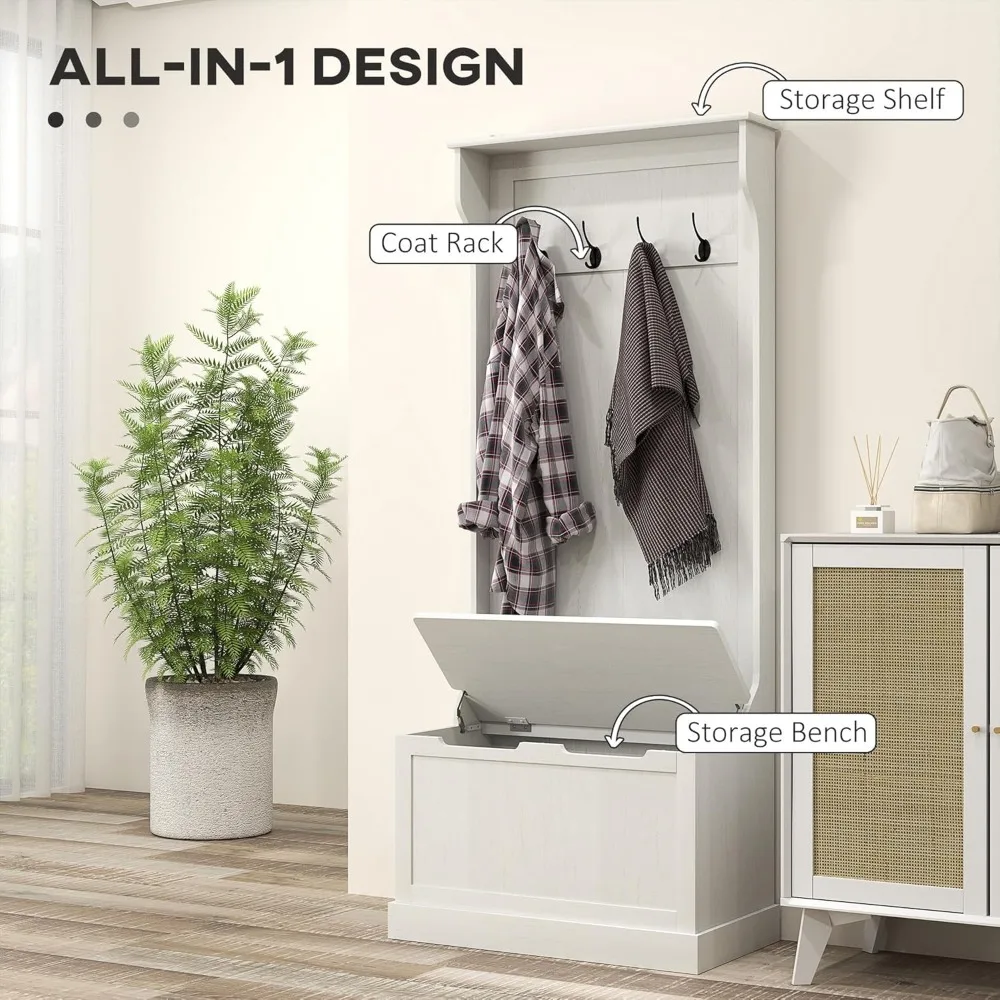
The beauty of entryway benches lies in their variety. Classic backless designs offer simplicity and space-efficiency, tucking neatly against walls in even the smallest entries. Their clean lines provide a perfect foundation for seasonal decor while offering a convenient spot to sit when putting on or removing shoes.
For homes where storage is a priority, benches with integrated storage solutions for entryway benches transform cluttered entries into organized welcome spaces. Look for designs featuring:
- Under-seat storage with hinged tops for concealing seasonal items
- Open shelving below for baskets that corral shoes and accessories
- Built-in cubbies that keep everyday items organized but accessible
- Drawer storage for items you want to keep out of sight
Perhaps the most functional option for busy households is a hall tree design for entryways. These all-in-one solutions combine seating with vertical storage elements like hooks, shelves, and sometimes cabinets. A well-designed hall tree bench addresses all the entryway’s needs in one cohesive piece, with hooks for coats and bags, seating for transitions, and often storage for shoes and accessories.
When styling an entryway bench, balance is key. Creating your dream rustic entryway involves thoughtful layering that enhances function without creating clutter. Consider these elements:
- A cushion or series of pillows to add comfort and color
- Baskets or bins that add texture while corralling small items
- Wall decor above that complements the bench’s scale and style
- Seasonal touches that can be easily swapped throughout the year
Size considerations are crucial for entryway benches. Measure your space carefully, leaving enough room for comfortable passage (at least 36 inches of walking space in front of the bench). Standard entryway benches range from 36 to 60 inches wide, 16 to 20 inches deep, and stand about 18 inches tall. Narrow hallways might benefit from slimmer profiles, while spacious foyers can accommodate larger statement pieces.
The material and finish of your entryway bench should be chosen with practicality in mind. This hardworking piece will see daily use and potential exposure to wet shoes and outdoor elements. Look for durable woods and resilient finishes that can withstand these demands while developing character over time.
An entryway bench does more than provide seating—it creates a deliberate transition space that welcomes family and guests while setting the tone for your home’s aesthetic. The right rustic farmhouse bench grounds this space with warmth and character while serving the practical needs of daily life.
Dining Room Benches: Fostering Casual Gatherings
Farmhouse dining has always been about gathering people together in comfortable, unpretentious settings. A rustic bench brings this welcoming spirit to modern dining spaces, encouraging lingering conversations and creating a relaxed atmosphere that formal chairs simply can’t match. The bench’s humble origins as farmhouse staples make them perfectly suited to spaces where food and fellowship are the focus.
Traditional backless dining benches offer several advantages. Their clean, streamlined profiles allow them to tuck completely under the table when not in use, making them ideal for smaller dining areas. The absence of a back also makes them versatile—they can be used from either side, accommodating an extra guest when needed. These simple forms let the beauty of the wood and craftsmanship take center stage.
For those who prefer more support during longer meals, bench designs with backs for added comfort make excellent dining companions. While they sacrifice some of the space-saving benefits of backless models, they compensate with increased comfort that encourages diners to linger. These designs often feature simple slat backs or gentle curves that maintain the rustic aesthetic while providing support.
Corner or L-shaped benches offer creative solutions for maximizing seating, especially in breakfast nooks or smaller dining spaces. By utilizing the corner space efficiently, these designs can seat more people in less space than traditional chair arrangements. Some incorporate storage under the seats, adding functionality to smaller dining areas.
When pairing benches with dining tables, proportion matters. The bench should be approximately the same length as the table side it will sit against, or slightly shorter (about 6 inches less on each end allows for comfortable access). Height relationships are equally important—look for a bench that provides about 12 inches of space between the seat and table surface for comfortable dining.
Many designers favor mixed seating arrangements that combine benches with chairs. This approach offers several benefits:
- Creates visual interest through varied forms
- Combines the comfort of chairs (typically at the table ends) with the space efficiency of benches
- Accommodates different comfort preferences among family members
- Allows for easier access on one side of the table
Comfort considerations shouldn’t be overlooked, even in rustic pieces. While farmhouse style embraces simplicity, that doesn’t mean sacrificing comfort. Consider adding cushions in durable, washable fabrics that complement your rustic aesthetic. Materials like cotton canvas, ticking stripe, or grain sack fabrics add softness while maintaining the farmhouse feel.
The beauty of rustic dining benches lies in their honest simplicity and ability to bring people together without pretense. They remind us that some of life’s most meaningful moments happen around the table, in settings that feel authentic and welcoming rather than formal or contrived.
Living Room Benches: Versatile Style Statements
The living room offers perhaps the most creative opportunities for incorporating rustic farmhouse benches beyond their traditional uses. Here, these versatile pieces can serve multiple functions while adding textural interest and character to your most-used space.

Coffee table alternatives represent one of the most innovative uses for rustic benches in living spaces. A substantial bench placed in front of a sofa creates a sturdy, characterful surface for books, trays, and decor while offering occasional seating when entertaining. Unlike conventional coffee tables, benches can be easily moved aside to create floor space for games or activities, making them ideal for family rooms.
Window seats created from rustic benches transform overlooked architectural features into charming focal points. Placed under a window, a simple bench creates an instant reading nook or contemplative spot. Add cushions and pillows for comfort, and you’ve created a destination that invites relaxation while showcasing the natural light and views.
In open floor plans, benches serve as excellent room dividers that define spaces without blocking sight lines or light. A bench with storage placed behind a sofa can separate living and dining areas while providing a surface for lamps or decorative items. This approach maintains the openness of the floor plan while creating visual boundaries between functional zones.
The ability to creatively place benches in living spaces gives them an advantage over more conventional furniture. Their modest profiles allow them to fit in transitional spaces like the area between a kitchen and living room, under stairways, or in awkward recesses that might otherwise go unused. This adaptability makes them valuable problem-solvers in challenging floor plans.
For entertaining, backless benches offer flexible seating that can be moved where needed, accommodating extra guests without the bulk of additional armchairs. Their low profiles make them unobtrusive when not in use, yet readily available when company arrives.
Styling living room benches requires a thoughtful approach:
- For coffee table applications, create vignettes with varied heights and textures
- For window seats or reading nooks, layer soft textiles that invite lingering
- For room dividers, consider how the bench looks from both sides
- For occasional seating, ensure the bench is lightweight enough to move easily
The beauty of rustic benches in living spaces lies in their chameleon-like ability to adapt to your needs. Unlike single-purpose furniture, these hardworking pieces earn their keep by serving multiple functions while adding authentic character to your most lived-in spaces.
Bedroom and Accent Benches: Adding Functional Elegance
The tradition of placing a bench at the foot of the bed dates back centuries, offering both practical function and visual balance to bedroom design. A rustic farmhouse bench continues this tradition beautifully, adding character and utility without overwhelming the room’s restful atmosphere.
The foot-of-bed placement remains the classic choice, creating a pleasing visual anchor that balances the bed’s volume while providing practical benefits. This location offers a convenient spot for placing items when changing bedding, a seat for putting on shoes, or temporary storage for throw pillows and blankets at night. The width of the bench should generally be about 6-12 inches narrower than the bed to create a balanced proportion.
Window benches in bedrooms transform overlooked spots into charming reading nooks or quiet retreats. Paired with good lighting and cushions, these create inviting destinations that encourage relaxation while maximizing natural light. The window bench combines the best of furniture and architecture, becoming an integrated design element that feels purposeful and organic to the space.
Dressing area benches provide practical seating during daily routines while adding character to vanity or closet spaces. Even in modest bedrooms, a small bench beside a dresser or near a mirror creates a dedicated spot for daily rituals that feels intentional and elevated.
When discussing accent bench placements in various rooms, it’s worth noting how these pieces can enhance transitional spaces throughout the home. A rustic bench in a hallway creates a moment of pause and interest in what might otherwise be merely a passage. Placed in a stairway landing, a small bench transforms an overlooked space into a reading nook or display area for cherished objects.
The bedroom offers unique opportunities to soften the rustic aesthetic while maintaining its authentic character. Cushioned bench options for comfort make particular sense here, where softness and comfort take priority. Consider these approaches:
- Natural linen or cotton upholstery in soft neutrals
- Drop cloth or grain sack cushions for texture with historical reference
- Subtle patterns like ticking stripes or muted plaids that maintain the rustic aesthetic
- Layered pillows that add comfort while allowing the bench’s structure to show
The bedroom bench should balance its decorative presence with genuine function. Even the most beautiful bench falls short if it becomes merely a collector of clothing. Consider your actual habits and needs when selecting both the style and placement of bedroom benches.
In smaller bedrooms, look for benches that incorporate storage to maximize functionality. A hinged lid or shelf below the seat can house extra linens, seasonal clothing, or bedding, making the bench an essential part of the room’s organization rather than merely decorative.
These thoughtfully placed benches create moments of intention throughout the home—spaces that invite pause, reflection, and enjoyment of your surroundings. Their modest scale makes them perfect for creating these intimate moments without overwhelming your spaces.
Outdoor Farmhouse Benches: Extending Rustic Charm to Nature
The farmhouse tradition has always blurred the lines between indoor and outdoor living. Rustic outdoor benches extend this welcoming aesthetic to porches, gardens, and patios, creating inviting spaces that connect home to landscape. These sturdy pieces weather gracefully over time, developing the kind of authentic character that can’t be manufactured.
Material selection becomes particularly important for outdoor applications. The best woods for exterior benches offer natural resistance to moisture and insects:
- Cedar: Contains natural oils that resist rot and repel insects, developing a silvery patina over time
- Teak: Premium choice known for exceptional weather resistance and dimensional stability
- Cypress: Contains natural preservatives that make it highly resistant to decay
- Black locust: Incredibly dense and naturally rot-resistant, often outlasting manufactured materials
Proper finishing dramatically extends the life of outdoor benches. Unlike interior pieces that might showcase raw wood, outdoor benches benefit from protective sealants that allow them to withstand the elements. Options include:
- Marine-grade spar varnish for maximum water resistance
- Penetrating outdoor oils that nourish wood while allowing it to breathe
- Semi-transparent stains that protect while highlighting natural grain
- Natural treatments like linseed or tung oil that require more frequent reapplication but maintain wood’s natural feel
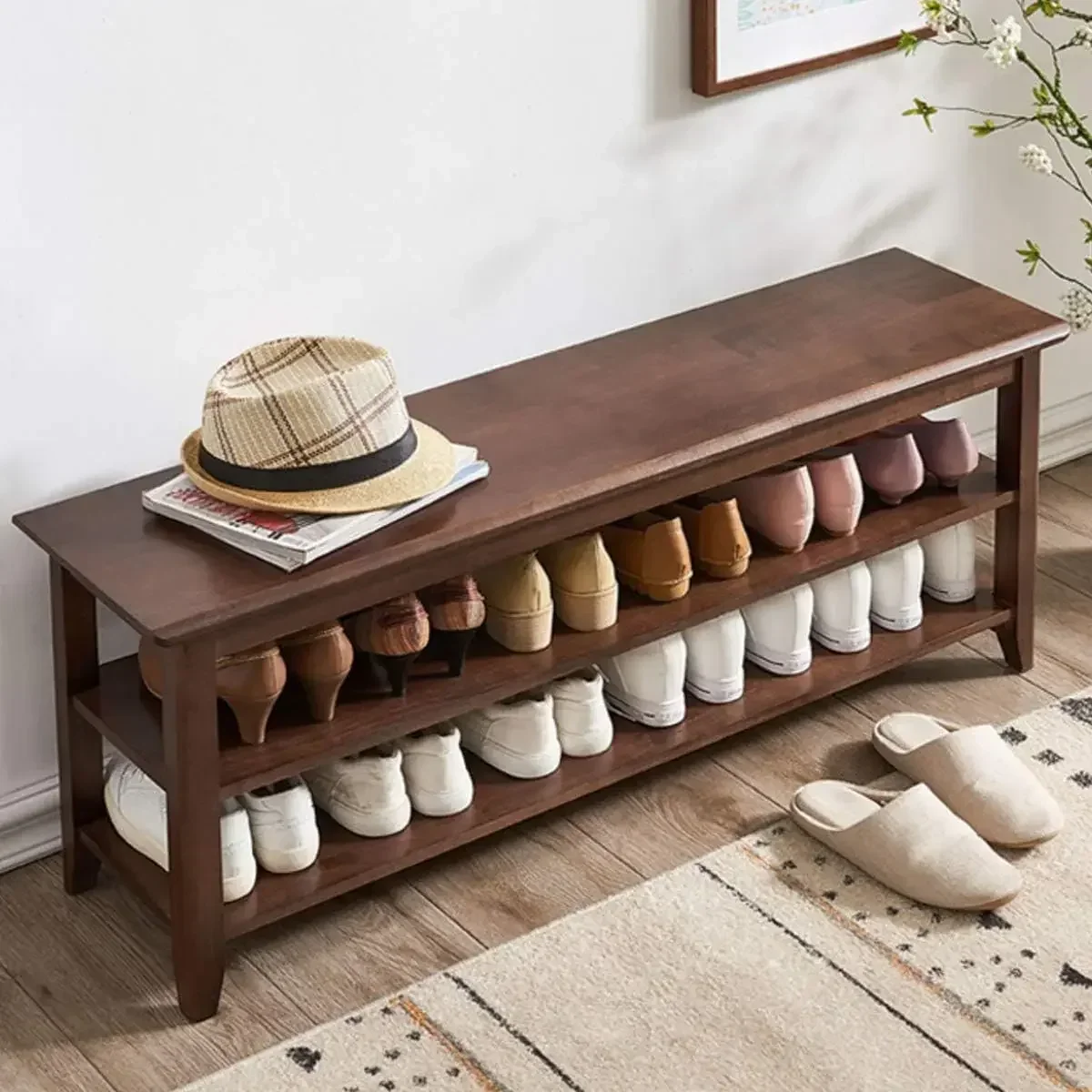
Placement considerations help maximize both the enjoyment and longevity of outdoor benches. Traditional locations include:
- Porch settings that offer some protection from direct elements
- Under mature trees where dappled shade creates restful retreats
- Alongside garden paths to create destination points
- Near water features where the bench provides a spot for contemplation
- Paired with outdoor tables to create casual dining areas
Seasonal care ensures that outdoor benches remain beautiful for generations. Develop a maintenance routine that includes:
- Clearing debris from bench surfaces regularly to prevent moisture trapping
- Washing with mild soap and soft brush at season’s beginning and end
- Reapplying protective finishes as needed (typically annually or biennially)
- Covering or storing benches during harsh winter months in severe climates
- Checking and tightening hardware that may loosen with temperature fluctuations
The beauty of outdoor farmhouse benches lies in how they age. Unlike many outdoor furnishings that deteriorate with exposure, quality wooden benches develop character and patina that enhances their appeal. The silvery gray of naturally aged cedar, the deepening honey tones of weathered cypress, or the rich patina of aged teak all tell stories of seasons passed and moments enjoyed.
These outdoor pieces create natural gathering spots that invite conversation and contemplation. They bridge the gap between structured home spaces and the natural world, offering comfortable places to enjoy morning coffee, afternoon reading, or evening conversations under the stars.
Materials & Finishes: The Foundation of Rustic Character
The soul of a rustic farmhouse bench lives in its materials and finishes. These elements determine not only how the piece looks but how it feels, wears, and ages over time. Understanding these foundations helps you make informed choices whether purchasing or creating farmhouse pieces.
Wood selection fundamentally shapes a bench’s character, with each species bringing distinct qualities:
Pine remains popular for its affordability and character. As a softwood, pine dents and distresses naturally with use, developing authentic wear patterns. Its prominent knots and grain variations create visual interest, while its light color provides versatility for various finishing techniques. While less durable than hardwoods, pine’s natural aging process embodies the lived-in quality central to farmhouse style.
Oak offers exceptional durability with distinctive character. Its prominent grain patterns create natural texture while its hardness ensures generations of use. Red oak brings warm, reddish-brown tones, while white oak offers more neutral, tan-to-brown coloration with greater water resistance. Oak’s strength makes it ideal for high-use pieces like dining benches.
Reclaimed woods tell stories through their previous lives. Salvaged from old barns, factories, or homes, these materials bring history and unique character impossible to replicate. The weathered patinas, nail holes, and saw marks speak to their past, while their dense old-growth grain patterns often offer superior stability. These woods connect to sustainable practices while creating truly one-of-a-kind pieces.
Alternative species each bring unique qualities. Elm offers distinctive interlocked grain patterns that resist splitting. Acacia provides rich color variation and natural water resistance. Maple brings exceptional hardness with subtle grain that works well in more refined farmhouse styles. Each offers distinctive character while maintaining the natural authenticity essential to rustic design.
Finishing techniques dramatically impact both appearance and durability. Different wood types and finishes create vastly different effects:
Natural wax and oil finishes penetrate wood rather than coating it, creating a low-luster finish that allows you to feel the wood’s natural texture. These finishes enhance grain patterns while providing modest protection. They require more frequent maintenance but allow the wood to breathe and age naturally.
Stain variations can dramatically alter wood’s appearance while still showcasing its natural grain. From weathered grays that mimic aged barnwood to warm honey tones that enhance pine’s character, stains offer tremendous versatility. Quality application involves careful sanding and preparation to ensure even absorption.
Paint techniques in farmhouse style typically embrace imperfection. Distressed finishes, where paint is selectively worn away to reveal wood beneath, create time-worn character. Whitewashing or color-washing applies diluted paint that allows grain to show through, creating subtle dimension. Milk paint, with its matte finish and tendency to chip naturally, offers particularly authentic results.
Protective clear coats provide durability without changing wood’s appearance. Water-based polyurethane offers good protection with low odor and easy cleanup, though it can appear more plastic-like than other options. Traditional shellac brings warm amber tones but offers less water resistance. Wipe-on poly provides a happy medium with good protection and a hand-rubbed appearance.
The combination of wood type and finish dramatically impacts a piece’s overall character. For authentic farmhouse style, the finishing approach should enhance rather than mask the wood’s natural character. Signs of quality finishing include:
- Smooth surfaces where appropriate (seating areas) with more textural elements maintained elsewhere
- Even application without drips or pooling in corners
- Attention to end grain, which absorbs more finish than face grain
- Protection appropriate to the piece’s intended use and environment
Understanding these material foundations helps you recognize quality in commercial pieces or make informed choices for DIY projects. The most successful rustic farmhouse benches honor their materials, allowing natural beauty to shine through thoughtful craftsmanship.
The Savvy Buyer’s Guide to Rustic Farmhouse Benches
Finding the perfect rustic farmhouse bench requires looking beyond surface appearances to evaluate quality, construction, and value. This knowledge helps you invest in pieces that will serve your home beautifully for years to come.

Quality indicators separate authentic pieces from mass-produced imitations. When evaluating quality in rustic furniture, examine these key elements:
- Solid wood construction throughout, not just on visible surfaces
- Wood thickness of at least 3/4 inch for structural elements
- Joinery methods that rely on wood-to-wood connections rather than just screws or staples
- Smooth operation of any moving parts like drawers, doors, or hinged lids
- Consistent finish application with attention to less visible areas
- Even distressing that appears naturally worn rather than mechanically repeated
Size and dimension guidelines ensure your bench will serve its intended purpose. Consider these standard measurements as starting points:
- Entryway benches: 42-60 inches wide, 16-20 inches deep, 18 inches high
- Dining benches: Length approximately 6 inches shorter than table side, 18 inches high, 15-18 inches deep
- Bedroom benches: 40-60 inches wide (about 12 inches narrower than the bed), 16-18 inches deep
- Living room/coffee table benches: 36-48 inches wide, 18-20 inches deep, 16-18 inches high
Price expectations vary widely based on materials, construction methods, and retail channels. While authentic rustic pieces represent an investment, they should offer value through quality construction and timeless design. Mass-produced pieces might cost $150-400, while bench-made or artisan-crafted pieces typically start at $400 and can reach $1500 or more for exceptional craftsmanship or premium materials.
The difference between authentic construction and mass-produced lookalikes often lies in the details. Mass production typically sacrifices traditional joinery for faster methods, uses thinner materials, and creates artificial “character” through mechanical distressing. True bench-made pieces show evidence of hand tools, feature time-tested joinery methods, and develop genuine character through quality materials and craftsmanship.
When shopping for rustic benches, consider these marketplace options:
- Dedicated furniture retailers specializing in farmhouse or rustic styles
- Artisan marketplaces connecting you directly with makers
- Antique or vintage dealers for authentic aged pieces
- Custom furniture makers for pieces tailored to your specific needs
Before purchasing, examine the piece thoroughly or ask detailed questions of the seller:
- What wood species is used throughout (not just on visible surfaces)?
- How are the joints constructed and reinforced?
- What type of finish is applied and how should it be maintained?
- What warranty or guarantee is provided?
- Are repair parts or touch-up materials available?
For custom or made-to-order pieces, inquire about customization options that might better suit your needs—modifications to dimensions, finish choices, or storage configurations that tailor the piece to your specific space and needs.
Quality bench options with coat racks combine the seating function with additional utility, creating multi-purpose solutions ideal for entryways and mudrooms. These pieces demonstrate how quality features in rustic entry furniture can maximize function without sacrificing authentic character.
Entryway Bench with Cushion, Mudroom Bench with Cushion, Shoe Bench for Entryway
$1,186.63 Select options This product has multiple variants. The options may be chosen on the product pageEntryway Bench with Back, Modern Entryway Bench, Shoe Bench for Entryway
Price range: $463.13 through $474.44 Select options This product has multiple variants. The options may be chosen on the product pageEntryway Bench with Shelf Storage, Shoe Bench for Entryway, Shoe Storage Bench
$194.08 Select options This product has multiple variants. The options may be chosen on the product pageCorner Entryway Bench, Entryway Bench with Cushion, Modern Entryway Bench, Shoe Bench for Entryway
$476.34 Select options This product has multiple variants. The options may be chosen on the product pageBench with Hooks and Storage, Entryway Hall Tree, Mudroom Bench with Cubbies, Mudroom Bench with Shoe Storage
$818.38 Select options This product has multiple variants. The options may be chosen on the product pageModern Entryway Bench, Wood Entryway Bench, Wood Mudroom Bench
$497.69 Select options This product has multiple variants. The options may be chosen on the product page
An informed approach to shopping helps you identify pieces worthy of investment—benches that will serve your home beautifully while developing the kind of authentic character that only comes with time and quality craftsmanship.
DIY Rustic Farmhouse Bench Projects: Creating Your Own Heirloom
Creating your own rustic farmhouse bench offers rewards beyond the finished piece itself. The process connects you to traditional craftsmanship while allowing you to customize dimensions, features, and finishes to perfectly suit your space. Projects range from beginner-friendly builds requiring minimal tools to more complex designs incorporating storage or specialized joinery.
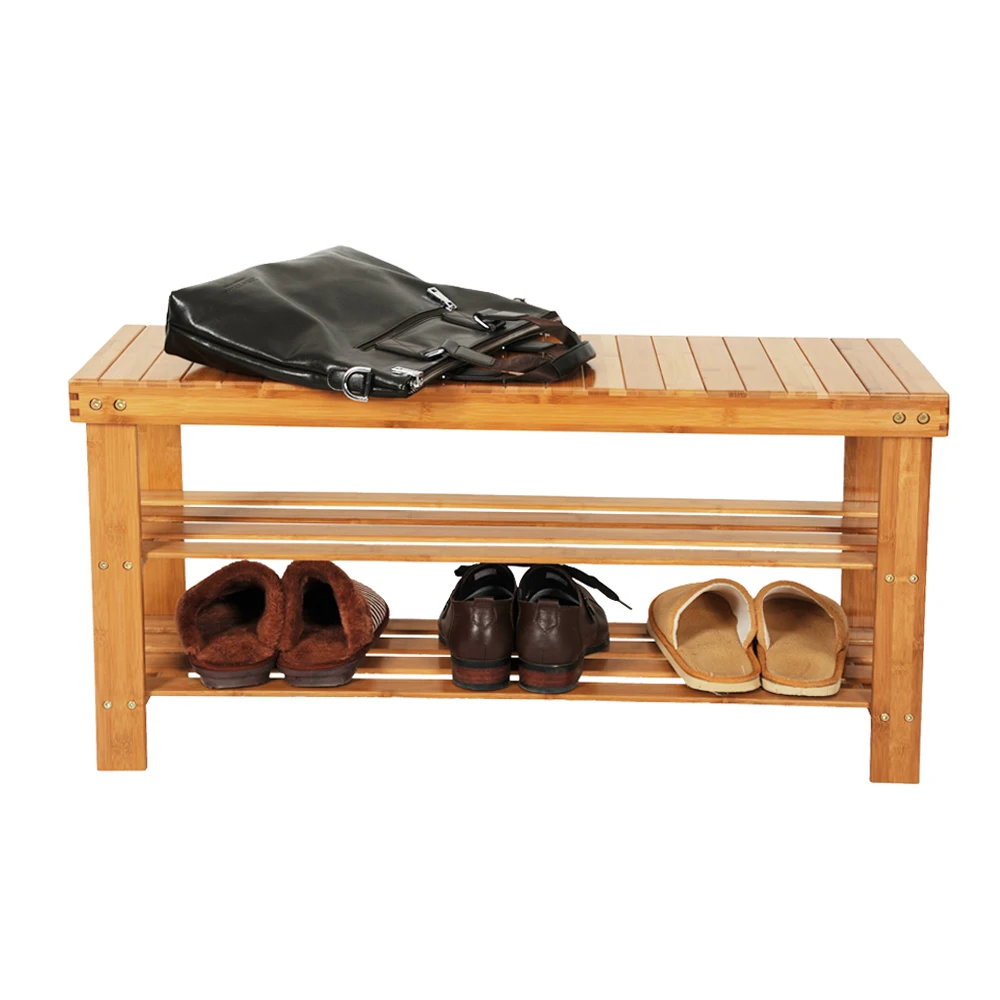
Beginner projects typically feature simple construction methods that require only basic tools:
– Simple plank benches using dimensional lumber (2x8s or 2x10s)
– Basic frame construction with screws and wood glue
– Straightforward finishes like stain and polyurethane
– Essential tools needed: circular saw, drill, sander, measuring tape, square
Intermediate designs introduce more complex elements:
– Traditional joinery like mortise and tenon or half-lap joints
– Tapered or turned legs for more refined appearance
– Breadboard ends to prevent warping on larger surfaces
– Additional tools needed: router, chisels, clamps, possibly a table saw
Advanced projects incorporate specialized features:
– Integrated storage with drawers or lifting lids
– Compound angles or curved elements
– Traditional joinery throughout without modern fasteners
– Advanced tools needed: table saw, jointer, planer, specialized jigs
Essential materials for DIY bench projects include:
– Quality lumber selected for straight grain and minimal defects
– Proper fasteners (screws should be appropriate length for the material thickness)
– Wood glue designed for strong wood-to-wood bonds
– Finishing supplies suitable for the bench’s intended location and use
Common challenges in DIY bench construction include:
– Ensuring level, wobble-free bases (solution: careful measuring and adjustable feet)
– Creating comfortable seat depths and heights (solution: test dimensions before final assembly)
– Achieving smooth, splinter-free surfaces (solution: progressive sanding through grits)
– Managing wood movement across seasons (solution: proper joinery methods that allow for expansion)
For those interested in custom-sized bench projects for narrow spaces, careful planning is essential. Create full-scale templates from cardboard to test dimensions in your space before cutting expensive materials. Consider the clearance needed around the bench and how it will be used in daily life.
The time investment for DIY bench projects varies considerably:
– Simple designs: 1-2 days including finishing time
– Intermediate projects: 2-4 days with appropriate dry times between steps
– Complex designs with storage: 1-2 weeks for careful execution and proper finishing
Creating your own rustic farmhouse bench connects you to traditional craftsmanship while allowing complete customization for your space. Whether you’re a novice woodworker or experienced craftsperson, there’s a bench project suitable for your skill level that will yield a meaningful piece for your home.
Crafting the Perfect Finish: Techniques for Authentic Character
The finishing process transforms raw wood into a durable, beautiful surface that enhances the bench’s character. For rustic farmhouse pieces, finishing techniques should highlight natural beauty while creating surfaces that can withstand daily use. Understanding these processes helps you achieve authentic results whether creating or refinishing pieces.
Natural aging versus artificial distressing represents a philosophical choice in rustic finishing. Natural aging occurs gradually as wood responds to use, light exposure, and environmental conditions. This process creates truly authentic character but requires patience. Artificial distressing uses techniques to simulate age:
- Strategic denting with chains, hammers, or other tools
- Wire brushing soft grain while leaving harder grain raised
- Selective sanding to create wear patterns in high-use areas
- Creating “history” through thoughtfully placed marks and dents
Layered paint techniques create depth and visual interest while suggesting years of use:
1. Apply base coat in chosen color and allow to dry completely
2. Apply contrasting color as top coat
3. While still slightly tacky, selectively sand raised areas where natural wear would occur
4. Seal with clear protective finish
For authentic color washing:
1. Mix paint with water at 1:1 ratio for translucent application
2. Apply with brush in direction of wood grain
3. Wipe back immediately with clean cloth to desired opacity
4. Allow to dry completely before sealing
Creating targeted wear patterns requires observation of how benches naturally age:
– Edges and corners show wear first
– Seats show circular wear patterns at sitting positions
– Areas where feet rest develop distinctive patterns
– Hardware surrounds often show concentrated wear
Protective finishes for rustic benches should balance durability with appropriate appearance:
– Matte or satin polyurethane provides excellent protection with minimal sheen
– Wax finishes offer a traditional look but require periodic renewal
– Penetrating oils enhance natural character but need more frequent maintenance
– Water-based finishes reduce yellowing over time compared to oil-based alternatives
Common finishing challenges include:
– Blotchy absorption in pine and other soft woods (solution: pre-conditioning the wood)
– Drips or runs in vertical surfaces (solution: thinner application of multiple coats)
– Dust nibs in final finish (solution: light sanding between coats and clean application environment)
– Inconsistent color in large surfaces (solution: mix all stain before beginning and maintain wet edge)
The most successful rustic finishes embrace imperfection within reason. Random character marks add authenticity, but structural integrity should never be compromised for aesthetic effect. The goal is to create pieces that look naturally aged rather than artificially distressed.
These finishing techniques transform wood into surfaces that tell stories, invite touch, and develop character with time. The most successful rustic finishes enhance rather than mask the wood’s natural beauty while providing adequate protection for years of use and enjoyment.
Styling Your Rustic Farmhouse Bench: Creating Context and Comfort
A rustic farmhouse bench provides the perfect foundation for creative styling that enhances both beauty and function. Thoughtful accessories transform these simple pieces into focal points that reflect your personal style while maintaining their authentic character.
Cushion and pillow selection adds comfort while creating visual interest. For rustic farmhouse styling, consider these textile options:
- Cotton canvas in neutral tones for clean simplicity
- Ticking stripe fabrics that reference traditional mattress covers
- Grain sack reproductions with subtle stripes or printing
- Natural linen for casual elegance and durability
- Wool plaids or checks for seasonal warmth
Proper sizing ensures cushions enhance rather than overwhelm the bench. For standard benches, aim for cushions 2-3 inches thick that leave 1-2 inches of wood visible on all sides. Secure cushions with non-slip backing or subtle ties to prevent shifting during use.
Complementary storage solutions enhance function while adding textural interest. Styling tips for farmhouse bench display often incorporate:
- Natural fiber baskets in varying sizes for practical storage
- Galvanized metal containers that reference traditional farm implements
- Wooden crates or boxes that echo the bench’s material
- Canvas or linen storage bins for softer elements
Seasonal decoration approaches keep your bench fresh throughout the year:
– Spring: Incorporate subtle botanical elements like small potted herbs or ferns
– Summer: Add casual elements like straw hats, market baskets, or lightweight throws
– Fall: Introduce warm textiles, small pumpkins, or dried natural elements
– Winter: Incorporate evergreen sprigs, pinecones, and cozy textiles
Color scheme considerations should complement rather than compete with the bench’s natural beauty. Build palettes around neutrals that echo the wood tones—warm whites, soft grays, natural linens, and earth-inspired hues. Add subtle accents of color through accessories that can be easily changed with seasons or moods.
Lighting plays a crucial role in showcasing rustic benches. Position pieces where natural light can highlight their texture and character. For evening hours, warm-toned lighting from simple fixtures complements the warmth of wood and creates inviting ambiance.
Creating effective vignettes around bench focal points involves thoughtful layering:
- Start with the bench as your foundation element
- Add textiles for softness and comfort
- Incorporate storage elements that serve real functions
- Include a vertical element (lamp, plant, wall decor) to create height
- Add small personal items that tell your story
For benches with specific functions like shoe storage with farmhouse styling, balance practical needs with aesthetic considerations. Ensure storage remains accessible while creating a cohesive look through thoughtful organization and complementary elements.
The most successful bench styling maintains the balance between beauty and function that defines farmhouse style. These pieces should look inviting and lived-in rather than precious or untouchable. The best styling enhances your daily experience of the piece while celebrating its honest materials and craftsmanship.
Care and Maintenance: Preserving Beauty for Generations
Quality rustic farmhouse benches are built to last generations, but proper care ensures they remain beautiful while developing the patina that makes them increasingly precious over time. Different materials and finishes require specific maintenance approaches to preserve their integrity and beauty.
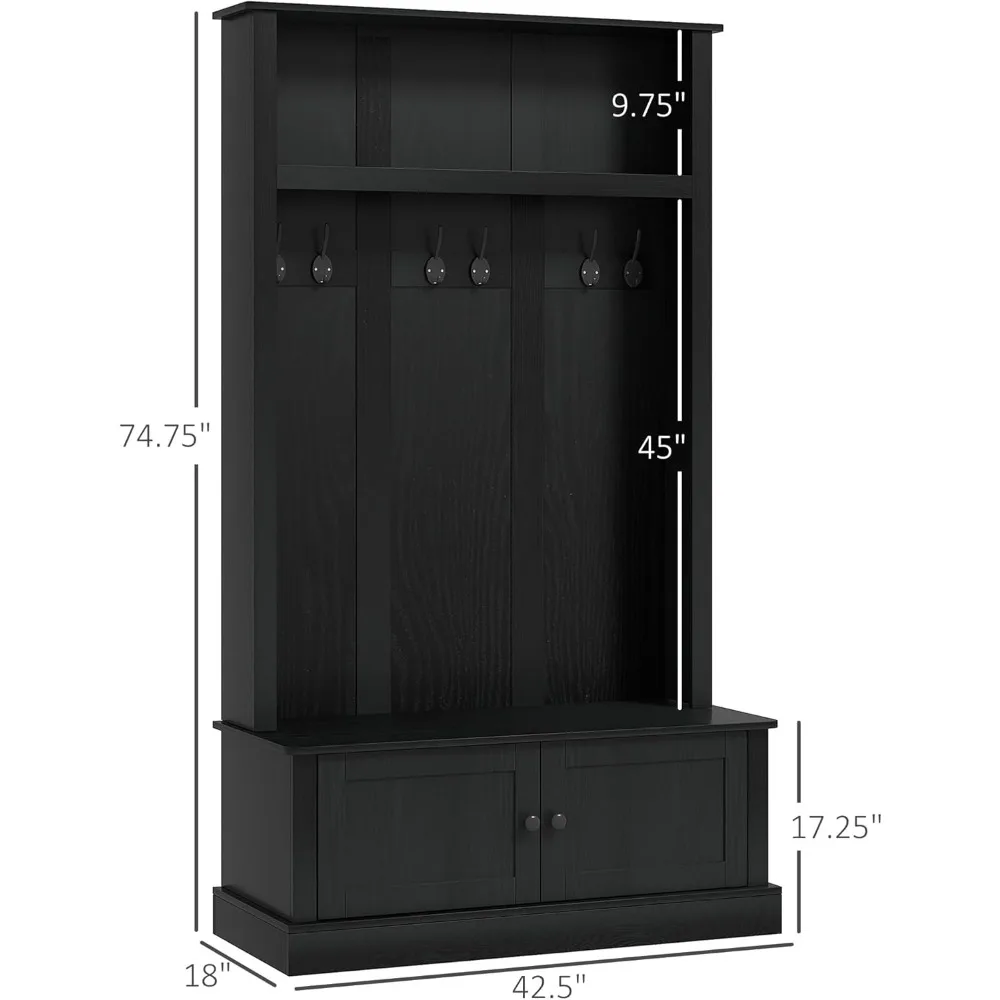
Regular cleaning prevents the buildup of dust and grime that can damage finishes over time. For most finished wood benches:
– Dust weekly with a soft, lint-free cloth
– Wipe with a slightly dampened cloth for deeper cleaning
– Follow the wood grain direction when cleaning
– Dry immediately with a clean, soft cloth
– Avoid standard furniture polishes that can build up over time
Different finishes require specific cleaning approaches:
– Polyurethane finishes can handle mild soap solutions when necessary
– Oil finishes benefit from products specifically designed for oiled wood
– Wax finishes should be cleaned with minimal moisture and rewaxed periodically
– Painted surfaces can typically be wiped with mild soap solutions but avoid abrasives
Seasonal maintenance helps prevent problems before they develop:
– Inspect joints and tighten any loose hardware
– Check for developing cracks that might need attention
– Re-oil or rewax surfaces as recommended for your specific finish
– Address any water rings or marks promptly before they set
– Rotate accessories and cushions to ensure even wear
Addressing wear and damage promptly prevents larger issues:
– Touch up small finish damages with appropriate materials
– Fill minor cracks with wood putty matched to your finish
– Address water damage immediately by drying thoroughly
– Consider professional help for structural repairs
Special considerations apply to different bench types:
– Storage benches: Periodically clean out and inspect interior spaces
– Outdoor benches: Provide protection during severe weather
– Upholstered elements: Clean fabrics according to their specific requirements
– Entryway benches: Protect from water damage with boot trays or mats
Understanding patina development helps you distinguish between desirable aging and damage requiring attention. Desirable patina includes:
– Subtle color changes as wood responds to light exposure
– Gentle softening of edges and corners from normal use
– Deepening luster as oils from hands subtly polish surfaces
– Minor dents and marks that tell the story of family life
When storing benches is necessary:
– Clean thoroughly before storage
– Store in climate-controlled environments when possible
– Cover with cotton sheets rather than plastic that can trap moisture
– Elevate from floors in basement or garage settings
– Remove cushions and store separately
With proper care, rustic farmhouse benches don’t just last—they improve with age, developing character and stories that mass-produced furniture simply cannot match. This journey of aging gracefully connects us to the natural materials and the generations who have appreciated them before us.
Why Rustic Farmhouse Benches Remain Timeless
In a world of disposable furniture and passing trends, rustic farmhouse benches stand apart as enduring pieces that transcend fashion. Their continued relevance speaks to something deeper than mere style—a connection to authenticity, craftsmanship, and functional beauty that resonates across generations.
The remarkable versatility of these pieces explains much of their staying power. From entryways to dining rooms, living spaces to bedrooms, and even outdoor settings, farmhouse benches adapt to our needs while maintaining their distinct character. Few furniture types can claim such flexibility without sacrificing their essential nature.
This adaptability extends beyond physical spaces to decorating styles. While firmly rooted in farmhouse traditions, rustic benches complement many design approaches:
– They add warmth to minimalist spaces
– They provide authentic character to modern rooms
– They enhance traditional settings with their honest simplicity
– They become statement pieces in eclectic collections
Beyond their practical versatility, rustic benches connect us to broader values that feel increasingly relevant. Their emphasis on natural materials provides a welcome counterpoint to our technology-filled lives. Their handcrafted nature celebrates human skill in an age of automation. Their durability offers sustainable alternatives to disposable consumption.
These pieces tell stories in ways that mass-produced furniture cannot. The visible grain patterns speak to the tree’s life and growth. The construction methods connect us to traditional craftsmanship. The patina that develops over years of use records family history in subtle marks and gentle wear. This narrative quality creates emotional connections that transcend mere utility.
Psychologically, natural elements like wood have been shown to reduce stress and create more welcoming environments. The tactile quality of rustic pieces—their varied textures and natural imperfections—engages our senses in ways that manufactured perfection cannot. These sensory experiences create more memorable and meaningful interactions with our homes.
Perhaps most importantly, rustic farmhouse benches create gathering places that foster connection. Whether it’s a mudroom bench where family members pause during comings and goings, a dining bench where friends linger over meals, or a garden bench that invites conversation, these pieces create natural centers for human interaction.
The sustainability aspect of quality rustic furniture becomes increasingly important in our environmentally conscious world. Well-made benches built from responsible materials and designed to last generations represent thoughtful consumption that reduces waste and resource use over time.
In their quiet way, rustic farmhouse benches remind us that some values transcend trends—quality materials, honest craftsmanship, functional design, and authentic character. Their continued relevance isn’t about fashion but about connecting to something more meaningful in our homes and lives.
Is a Rustic Farmhouse Bench Right for Your Space?
As you consider adding a rustic farmhouse bench to your home, you might wonder how these characterful pieces will integrate with your existing decor and meet your specific needs. These questions can help you determine if a farmhouse bench is the right choice for your space.
How does a rustic bench work with different decorating styles?
While naturally at home in farmhouse interiors, rustic benches are remarkably adaptable. In modern spaces, they add warming texture and organic elements that soften minimalist design. In traditional rooms, they contribute casual comfort that balances more formal pieces. Even in eclectic settings, their honest simplicity provides a grounding element amid more dramatic furnishings.
Will a rustic bench look out of place if I don’t have a fully farmhouse-styled home?
Not at all. The beauty of rustic pieces lies in their versatility as accent elements. A single farmhouse bench can introduce natural texture and character without requiring a complete farmhouse aesthetic. Think of it as adding a touch of warmth and history rather than committing to an entire design scheme.
How do I determine if my space can accommodate a bench?
Start by measuring the available area, remembering to allow for comfortable movement around the piece. Standard clearances include:
– 36 inches minimum for walkways around benches
– 18 inches between a bench seat and dining table edge
– 24-30 inches of clear space in front of entryway benches
What if I love the look but worry about comfort?
Comfort concerns can be easily addressed through thoughtful additions. Cushions in varying thicknesses can transform even the most rustic bench into a comfortable seat. For dining applications, consider shorter sitting periods or cushions for extended meals. Some designs incorporate subtle ergonomic elements like slight seat contours or angled backs while maintaining rustic character.
Can rustic benches work in small spaces?
Absolutely. In fact, functional seating solutions for smaller spaces often benefit from the clean lines and multi-functionality of benches. Their backless design consumes less visual space than chairs, and many styles can tuck completely under tables when not in use. Look for narrower profiles (12-14 inches deep) for tight spaces or corners.
What about durability with children and pets?
Rustic farmhouse benches may be the perfect choice for active households. Their sturdy construction and distressed finishes often hide additional wear better than more refined furniture. Minor dents or scratches add to the character rather than detracting from it. Look for smooth, splinter-free surfaces and non-toxic finishes for family safety.
Which room would benefit most from adding a rustic bench?
Consider where you most need additional seating or storage, or which space could use a touch of warmth and character. Entryways often gain the most dramatic functional improvement, while dining areas benefit from the space efficiency and casual atmosphere benches create. Living spaces gain flexible seating, while bedrooms receive a finishing touch that enhances both function and style.
What if I can’t find a bench with the exact dimensions I need?
Custom options are worth exploring for challenging spaces. Many craftspeople specialize in rustic furnishings and can create pieces to your exact specifications. Alternatively, consider DIY options that allow complete customization while creating a piece with personal meaning and history.
The beauty of rustic farmhouse benches lies in their adaptability to your unique needs and spaces. Whether purchased or handcrafted, these versatile pieces offer functional charm that complements nearly any home while creating gathering spaces that foster connection and comfort.


